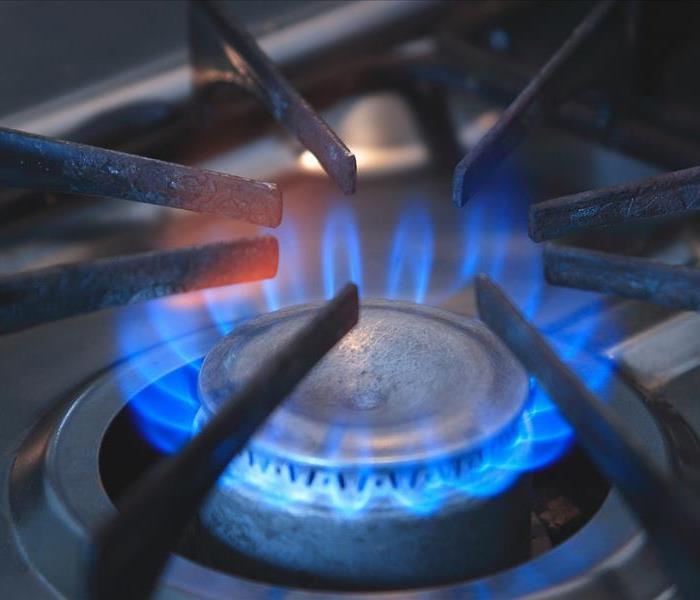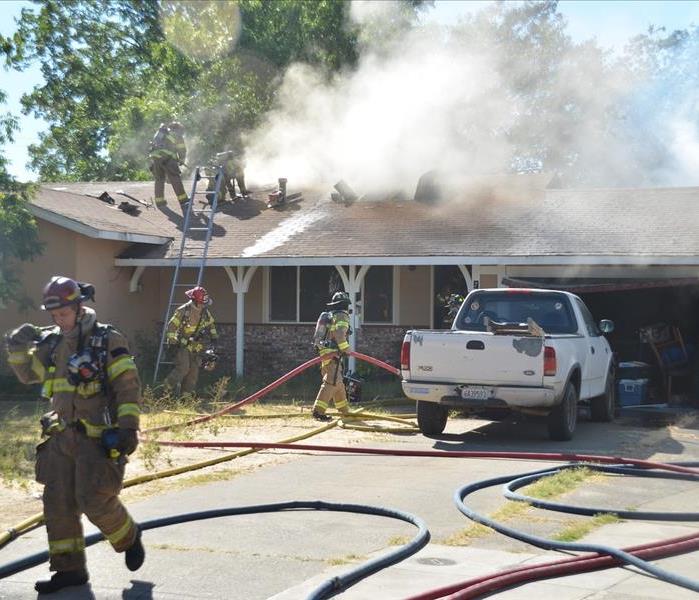Archived Fire Damage Blog Posts
Protect Your Home: Understanding Fire Hazards and Prevention
4/15/2024 (Permalink)
Your home is your sanctuary, but it's also essential to recognize the potential fire hazards and take proactive steps to prevent a fire. Understanding common fire hazards and implementing preventive measures can help protect your family and property. Here's what you need to know:
1. Electrical Hazards: Electrical malfunctions are a leading cause of home fires. Overloaded circuits, frayed wires, and faulty electrical appliances can spark a fire if left unchecked. To prevent electrical fires, avoid overloading outlets, inspect cords and appliances regularly for signs of damage, and consider upgrading outdated electrical systems to meet current safety standards.
2. Cooking Accidents: The kitchen is a high-risk area for fires, with cooking-related incidents accounting for a significant percentage of home fires yearly. Never leave cooking food unattended to prevent kitchen fires. Keep flammable materials away from heat sources and have a fire extinguisher readily accessible. Additionally, ensure that your stove and oven are kept clean and free of grease buildup, which can fuel a fire.
3. Heating Equipment: Improper use of heating equipment, such as space heaters, furnaces, and fireplaces, can pose a fire hazard if misused. Keep flammable materials at least three feet away from heating sources, never leave space heaters unattended, and have heating systems inspected and maintained regularly by a qualified professional. Install smoke and carbon monoxide detectors in every bedroom and level of your home for added safety.
4. Flammable Materials: Improperly storing flammable materials such as gasoline, propane, and cleaning chemicals can increase the fire risk. Keep combustible liquids away from heat sources and ignition points in well-ventilated areas, and store them in tightly sealed containers to prevent spills. Dispose of oily rags and other combustible materials safely to avoid spontaneous combustion.
5. Electrical Fire Safety: If an electrical fire does occur, it's essential to know how to respond safely. Never use water to extinguish an electrical fire, as water can conduct electricity and worsen the situation. Instead, use a fire extinguisher labeled for use on electrical fires or smother the flames with a heavy blanket or non-flammable material. If you cannot extinguish the fire quickly and safely, evacuate the premises immediately and call 911.
Understanding common fire hazards and taking preventive measures can reduce the fire risk in your home and protect your family and property. Stay vigilant, practice fire safety, and be prepared to respond quickly in an emergency.
4 Fire Safety Tips for Kids
4/26/2023 (Permalink)
4 Fire Safety Tips for Kids
Worksheets, activities, and lessons to teach your kids about fire safety and prevention.
1. Go to a firefighter in an emergency. Young children may be scared when they see a firefighter in full gear. Explain to children
- What firefighters wear and why.
- How a firefighter can help if there is a fire.
Contact your local fire station to arrange a tour. The children can learn about the equipment and become familiar with what firefighters look like and what they do.
2. Crawl low under smoke.
- Tell children that some fires make lots of smoke, which is dangerous to breathe.
- Show them how to respond when a room fills with smoke: get on your hands and knees, keep your head up, and crawl outside.
- Ask children to practice with you. Lead them in, crawling across the room with their heads up.
3. Stop, drop, and roll. When children’s clothes catch fire, their first reaction may be to run. This can make the fire spread faster. Show children the safest way to respond:
- Stop, cover your face, get down on the ground, and roll from side to side until you smother the fire.
- Ask children to practice with you a few times and then split them into pairs. Children can take turns demonstrating to their partners.
4. Tell a grown-up. Emphasize to children that match and lighters are tools that only adults use.
- Tell children that they should not play with or even touch these materials.
- Explain that they should tell a grown-up immediately if they find a match or lighter.
- Role-play with children in small groups about what to do when they find these materials.
Prepare for Pet Safety
1/29/2023 (Permalink)
Pets are family, too!
A fire emergency can occur in our servicing areas at any given moment. Though unexpected, it can be instrumental in having already a strategy in place for everyone, pets included, in your home to evacuate and meet in a safe location. While you should always be most focused on keeping yourself and your family safe, you can be better prepared to keep your pets safe during a fire emergency by following these safety tips:
Practice Evacuating
In the confusion and fear caused by a fire, it can be hard to think of everything you need to do at that moment. If you already have a plan and practice it a couple of times, you can be more prepared to handle a fire emergency. This can be helpful for pet safety and the safety of everyone in your household.
Notice Your Pets Location
An important part of the planning process can be knowing where your pets spend most of their time. It can be especially helpful to note where they hide when frightened, maybe during a thunder or lightning storm. You don’t want to put yourself or your family at risk by spending too much time searching for your dog or cat during a fire emergency.
Keep Any Collars and Leashes Nearby
Fire emergencies can be especially frightening to pets. By keeping their collars, leashes, or carriers handy, you can more easily lead them safely out of the house. If you cannot find your pets, it can be easier for the fire department to get them out if they are wearing collars. It can be a good idea to hang leashes by the door you plan to evacuate through.
Kitchen Fire Safety
9/15/2022 (Permalink)
From 2010-2014, the U.S. fire department s responded to an average of 166,100 home structure fires that involved cooking equipment per year. These fires caused an average of 480 civilian fire deaths, 5,540 civilian fire injuries, and $1.1 billion in direct property damage.
Here are a few tips on how to prevent kitchen fires and keep your family safe.
- Stay in the kitchen do not leave food unattended on the stove.
- Watch your clothing. Keep long flowing sleeves and large fitting shirts tied back while cooking.
- Keep a fire extinguisher near or in the kitchen
- Do not leave towels or oven mitts close to the hot burner.
- Change the batteries in your smoke detector regularly.
For smoke or fire damage call SERVPRO of Farmington; we are always here to help! (573) 756-5191
Two Minutes and Counting
9/15/2022 (Permalink)
Did you know that if a fire starts in your home, you may have just two minutes to escape?
The most effective way to protect yourself and your home is to identify and remove fire hazards. 60 percent of house fire deaths occur in homes with no working smoke alarms. During a home fire, working smoke alarms and a fire escape plan that has been practiced regularly can save lives.
Fire Safety Tips
- If a fire occurs in your home, GET OUT, STAY OUT and CALL for help.
- Install smoke alarms on every level of your home, inside bedrooms and outside sleeping areas.
- Test smoke alarms once a month; if they’re not working, change the batteries.
- Talk with all household members about a fire escape plan and practice the plan twice a year.
Fire and smoke damage is especially destructive. In many instances, your Farmington, MO property will suffer water damage from firefighting efforts. We specialize in fire and water damage restoration; it’s the cornerstone of our business. We have specialized equipment, specific training, and certifications that allow us to restore your home to pre-fire condition.
We understand you may be feeling confused, stressed, and more than a little vulnerable. Our technicians will treat your family with empathy and your home with great care. Until help arrives, please refer to our Fire Damage Tips—Until Help Arrives Guide and follow these tips to protect yourself and your property.
Our Fire Damage Restoration Services
Since each smoke and fire damage situation is a little different, each one requires a unique solution tailored for the specific conditions. When various materials burn, the soot and residue they create differ greatly and require a specific cleaning procedure. The steps listed below illustrate our process for the “typical” fire damage restoration.
- Emergency Contact
- Inspection and Fire Damage Assessment
- Immediate Board-Up and Roof-Tarp Service (if needed)
- Water Removal and Drying (if water damage is present)
- Removal of Smoke and Soot from All Surfaces
- Cleaning and Repair
- Restoration
Locally Owned Company with National Resources
SERVPRO of Farmington is locally owned and operated and we are proud to be part of this community. We are also part of a national network of over 1,650 Franchises with special Disaster Recovery Teams placed strategically throughout the country to respond to large-scale fire, water, and storm disasters.
Understanding Fire Extinguishers
9/17/2021 (Permalink)
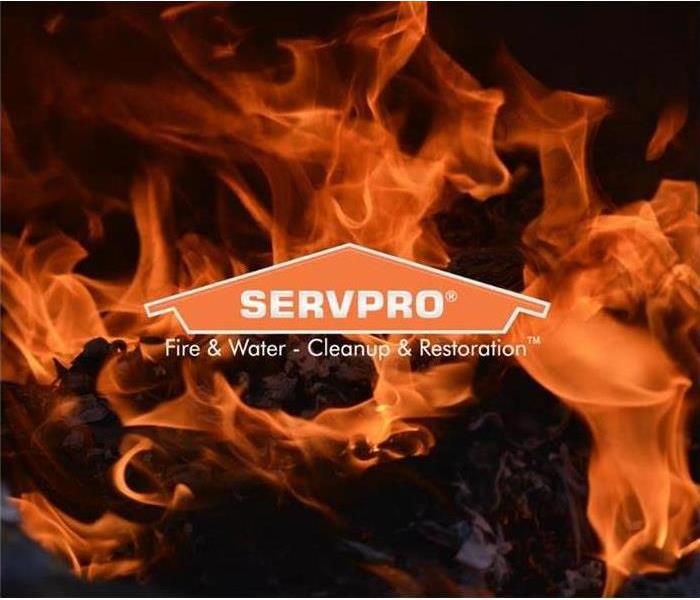 If a fire occurs in your home or business, give us a call!
If a fire occurs in your home or business, give us a call!
Fires most often erupt without warning, and double in size within seconds - knowing what to do and how to do it is critical when faced with this emergency situation. Understanding types of fires, fire extinguisher coding and proper usage is a cornerstone in life safety and property damage minimization. The type of combustible material determines the fire classification and fire extinguisher codes correspond to fire classifications.
Fire Classes and Corresponding Fire Extinguisher Codes
- Class (A) Fire is a fire with a combustible material of wood, paper, plastic or clothing. It is generally the easiest fire to put out. A Class (A) fire can be extinguished with water or foam. A Class (A) fire extinguisher will put out these fires
- Class (B) Fire has a combustible material of oil, grease, gas or alcohol. A Class (B) Fire cannot be extinguished with water. The use of water will cause the fire to spread by causing the combustible material to splatter or lift above the water. Many injuries have occurred to people improperly extinguishing a grease fire. A Class (B) Fire extinguisher uses dry foam or carbon dioxide to suppress the fire.
- Class (C) Fire is an electrical fire. Electrical fires can be caused by a malfunctioning appliance, faulty wiring, or an overloaded outlet. This type of fire cannot be extinguished with water. Water will intensify the fire because it conducts electricity. A Class (C) fire is suppressed with carbon dioxide or dry powder.
- Class D Fire has combustible metals as its material source. A Class (D) fire is extinguished with dry powder. The dry powder removes the fuel from the oxygen and extinguishes the fire. A Class (D) fire is not common in homes.
The best type of fire extinguisher to purchase for home use is an A, B, C extinguisher. This multipurpose extinguisher can put out most common fires. Once purchased, place your extinguishers in highly visible areas. Check the gauge of the extinguisher monthly to make sure they are properly pressurized. Replace them if not.
How to use a fire extinguisher – Use the acronym PASS:
- Pull the pin.
- Aim nozzle at the base of the flames
- Squeeze the nozzle
- Sweep back and forth until flames are extinguished
(If flames reignite, repeat the process.)
It's Officially Candle Season!
9/16/2021 (Permalink)
 Be cautious with candles!
Source: https://www.southernliving.com/home/best-fall-candles
Be cautious with candles!
Source: https://www.southernliving.com/home/best-fall-candles
Be Cautious When Using Candles
Yes, that soft light and aromatic fragrances that fill the room from a lit candle can be an easy way to create the atmosphere that you want in your home. However, candles can also become a safety hazard if they are not used properly. Candle fires are common, but the following tips can help you avoid them.
Don’t Leave Burning Candles Unattended
It may seem like an annoyance to extinguish a candle every time you leave the room. However, leaving it burning could result in a candle fire if something gets too close to the flame or if it burns too low. It is best to blow out candles before going to bed at night, even if the candle is in the same room you sleep in..
Keep Them Away From Flammable Items
When you are using a candle, you should be sure to have the area free of flammable objects. This can include papers as well as fabrics such as curtains and bedding. These types of items should be at least a foot away from any candles that are in use. Flammable liquids should be kept even further away.
Keep Them Out of Reach of Pets and Children
Both children and pets often come with an excess of energy and curiosity. For this reason, it can be easy for them to inadvertently start a candle fire. Keep burning candles in an area that are not within reach of a child or pet, especially unsupervised!
Use an Alternative
Perhaps the easiest way to prevent a is simply not to use candles at all. There are a variety of other ways that you can achieve a more relaxing home environment. If you are only interested in adding a nice scent to your home, a wax warmer is a great option. One great option is a diffuser. Diffusers are a great alternative to candles and make you house smell fantastic!
While these tips can help you prevent an emergency, accidents can still occur. Whether it is small or large, fires often require smoke cleanup and some repairs. If this happens, a fire damage restoration company like SERVPRO can help return your home to its preloss condition making it "Like it never even happened."
Overcoming Smoke and Soot Damages in Your Home
8/18/2021 (Permalink)
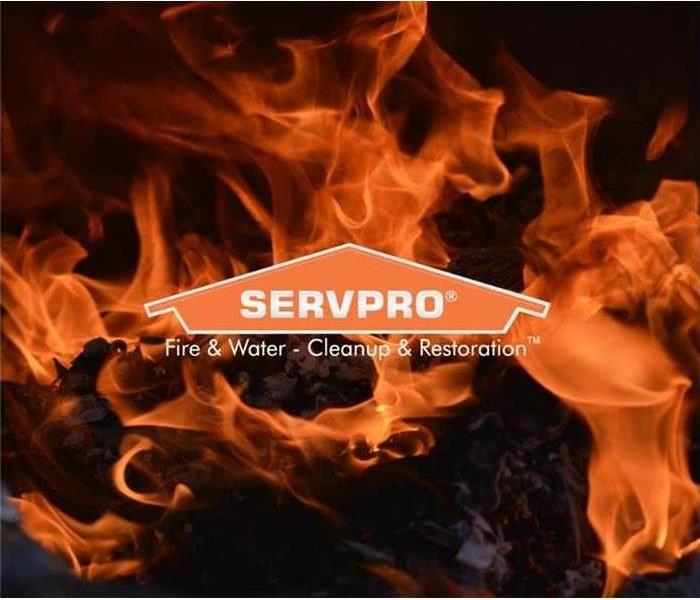 Give us a call anytime, 573-756-5191.
Give us a call anytime, 573-756-5191.
SERVPRO Understands That Recovering From a Fire in Your Home Includes Removing the Lingering Odors
Fires often present multiple damaging effects to homes. While there are very few that a homeowner can handle on their own, the majority of these lingering symptoms from a recent disaster like this require professional restoration services to return your house to normal. Regardless of the severity of the fire, cleaning up the damages and bringing your home back to preloss conditions takes expertise and the right equipment.
Smoke and soot, along with a harsh odor, are fire damage effects typical of house fires, regardless of their size or destructive force. Fighting these effects is something that our SERVPRO technicians prepare for and get explicitly trained to restore. While many homeowners might believe that counteracting the odor in their homes with a more pungent scent can overcome their issue, deodorization is the only sure way to remove a noxious scent.
Deodorization After Fire Damage
Deodorization is a process that utilizes several pieces of equipment to accomplish, but primarily, the job falls to our thermal foggers. The chemical compound that they release can get used to treat both the air in the affected areas of your home and affected furniture, textiles, materials, and fabrics. The solution breaks apart smoke molecules in the environment and neutralizes them to leave a scentless area behind to doctor as you see fit.
Soot Damage Removal
Cleaning up soot damage is another common effect that our SERVPRO technicians get asked to remedy, and there are a few approaches that we use to do it. Soot can often get cleaned from hard surfaces using specialized vacuums or by cleaning the area with a wet or dry sponge. Set in soot might require more aggressive measures. While the goal is to restore these walls to their original condition, sometimes the severity of damage can only allow for restoration to prepare for repainting or resurfacing.
While every home fire might be different between its location and severity, some symptoms are universal to nearly every occurrence. When you are looking for a trusted team to help you overcome the effects of a recent fire in your home, you can rely on SERVPRO of Farmington. Give us a call anytime you need us at 573-756-5191.
After My House fire, Can I Salvage my HVAC (Heating, Ventilation, and Air Conditioning) System?
8/18/2021 (Permalink)
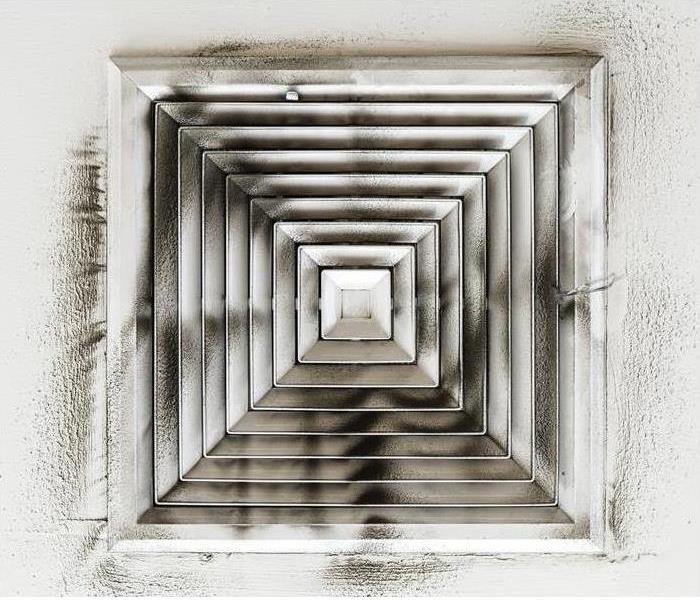 What's lurking in your duct work after a fire?
What's lurking in your duct work after a fire?
SERVPRO Restoration Technicians Clean and Restore Ducting and HVAC Systems
Charred furniture, strong odors, and thick smoke residue dusted throughout your home are alarming after-shocks from the fire. It is crucial to begin repairs right away; however, it is also essential to assess hidden damage and detect soot and smoke odor hiding in out-of-the-way-places such as your HVAC system.
If There Is No Visible Damage, Do Technicians Still Need to Clean the Ducting?
Yes, Technicians Clear Debris from Ducting and Seal in Odors to Mitigate Further Damage
Part of the fire-damage found in your home may be hiding in your ducting. Imagine finishing a restoration project, only to smell smoke or see soot in the air, bringing you back to square one. As a standard component of repairs after a fire, it is essential to inspect and clean the HVAC system immediately to determine the air quality within your home.
How Do SERVPRO Technicians Address Smoke Residue Inside Ducts?
- First, technicians make sure the system is off and not circulating contaminants throughout your home.
- Technicians clean the HVAC system by blowing and vacuuming debris and smoke residue.
- After adequate cleaning, technicians may seal the ducting to create a protective coating on the surface, effectively stifling any remaining odor.
What Equipment and Products Are Beneficial in Sealing and Cleaning the HVAC System?
- Duct cleaning systems like the Nikro PDC 4000 include a rotary brush for cleaning and a discharge hose to remove waste easily.
- After cleaning, technicians may use a ULV (ultra-low-volume) fogger to mist Duct Sealer inside the ducts to create a flexible film that seals the surface to contain odors.
For prompt 24/7 assistance after a fire, contact SERVPRO of Farmington at 573-756-5191. We make it, "Like it never even happened."
What To Do With Your Electronics After a House Fire
8/17/2021 (Permalink)
 We are here to help with any fire damaged electronics. Give us a call anytime, 573-756-5191.
We are here to help with any fire damaged electronics. Give us a call anytime, 573-756-5191.
After experiencing a house fire, you might feel overwhelmed trying to figure out what in your home is still salvageable and what needs to be thrown out for good. If any of your electronics have been affected by smoke, fire, or water, you might assume they’ll be too damaged to function. If any of your electronics have been affected by smoke, fire, or water, you might assume they’ll be too damaged to function. However, with the help of a fire cleanup company, your electronics can potentially be cleaned and restored to working condition. For the best chances of saving your items, keep in mind the following tips.
Important Tips for Handling Electronics Right After a Fire
While a professional can potentially clean your electronics and save them from harm, it is important you handle all electronics correctly to prevent causing irreversible damage or even harming yourself.
- Never turn on or use an electrical device you feel has experienced water, fire, or smoke damage
- If possible, unplug all electronics and appliances
- Avoid handling electronics visibly burned by fire
- Locate warranty records
- Don’t attempt to clean electronics yourself
- Immediately contact a professional for assistance
The Electronics Fire Cleanup Process
The first step a restoration specialist will take when attempting to restore your electronics is to perform a surface clean of the device. They will wipe the exterior of devices to prevent more damage from occurring and will carefully clean all metal components. They’ll also use a vacuum to fully remove all ash and soot.
After assessing the amount of damage to the device, the specialist will back up data if possible. This can involve transferring data to a completely new device or storing it using a cloud storage solution. Once this is complete, they’ll make any necessary repairs to restore the device.
Your electronics may be very valuable or contain important information you don’t want to lose. With the help of a fire cleanup specialist, it is possible your electronics can be saved even after a house fire.
What is ozone?
8/12/2021 (Permalink)
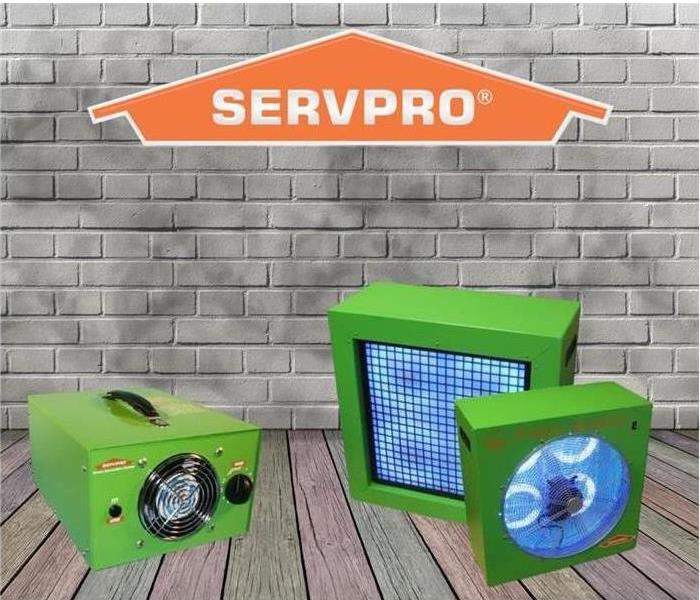 Here are some photos of our ozoning equipment.
Here are some photos of our ozoning equipment.
If you have ever had a fire on your property and had SERVPRO come out to restore, you will know what an ozone generator is. For those who have not, an ozone generator is a machine that charges the air around it is creating O3 out of the O2 molecules we breathe.
What We Use Ozone For
The primary function that we use an ozone generator for is the eliminate odors, especially odors caused by fires. We can use this technique of odor removal in many different cases such as, clothing, furniture, and entire rooms no matter the size. While the odor removal works great, there is a downside to using ozone in excess.
Precautions to Ozone
As stated earlier, ozone is different from the air we breathe. This reaction makes O3 poisonous if it is ingested in excess. Therefore, we close off the area that is being deodorized during the process. You can trust that we take every precaution necessary to keep our customers and employees safe.
Trash or Keep?
8/9/2021 (Permalink)
 This is a local fire where food needed to be disposed of.
This is a local fire where food needed to be disposed of.
What to Toss After a Fire
After a fire, there are some items you may be able to salvage and restore. However, there are other items that you should throw away. If you’re not sure what is worth keeping and what you should get rid of, check out these three suggestions:
1. Makeup. After spending hundreds of dollars on the best foundations, concealers, and eyeshadow palettes, no one wants to trash some of their most valuable makeup. Unfortunately, the makeup you’d normally wear may no longer be in such good condition due to the high flame heat. Some of these products may have melted and are no longer usable at all.
2. Medication. If your medicine cabinet was slightly destroyed by the fire and smoke in the home, throw away the medication and talk to your physician about getting refills. Most physicians are understanding about situations like this because it’s not safe to take medication that has been exposed to such heat in the first place.
3. Food. If food smells like smoke and there is soot on it, toss it in the trash. You may not like the idea of wasting food you’ve purchased, but it’s simply not safe to eat any contaminated food due to the chemicals commonly used to put out fires. You never know if those chemicals are on certain products, such as your bread, crackers, and even your box of cereal, so don’t take any risks.
Don't let a fire get you down!
9/14/2020 (Permalink)
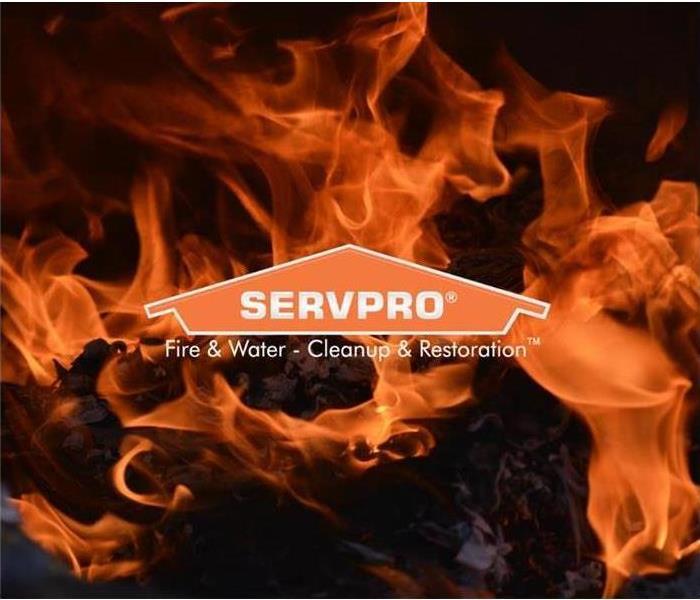 Call us anytime at 573-756-5191 for all your fire damage needs.
Call us anytime at 573-756-5191 for all your fire damage needs.
At SERVPRO® our priority is returning damaged property and items to their preloss condition. Whether natural or man-made, a disaster at one of your client’s facilities needs to be handled by professionals who understand the importance of your tenants’ safety. At SERVPRO® our teams are trained in helping manage both commercial and multi-family properties during the recovery process while maintaining the security and safety of the facility and tenants. Our professionals work hard and fast to minimize the interruptions for your tenants’ daily operations.
Emergency Fire Damage Tips
- Keep hands clean.
- Limit movement in the home to prevent further damage.
- Place dry, colorfast towels or old linens on carpeted traffic areas to prevent more soiling.
- If electricity is off, empty freezer and refrigerator and prop doors open.
- Wipe soot from chrome on faucets and appliances then protect with a light coating of lubricant.
- Do not attempt to wash any walls or painted surfaces without first contacting a SERVPRO® professional.
- Do not attempt to shampoo carpet or upholstered furniture without first consulting a SERVPRO® professional.
- Do not attempt to clean any electrical appliances that may have been close to fire or water without consulting a repair service.
Call SERVPRO of Farmington at 573-756-5191.
Advice from American Red Cross
9/14/2020 (Permalink)
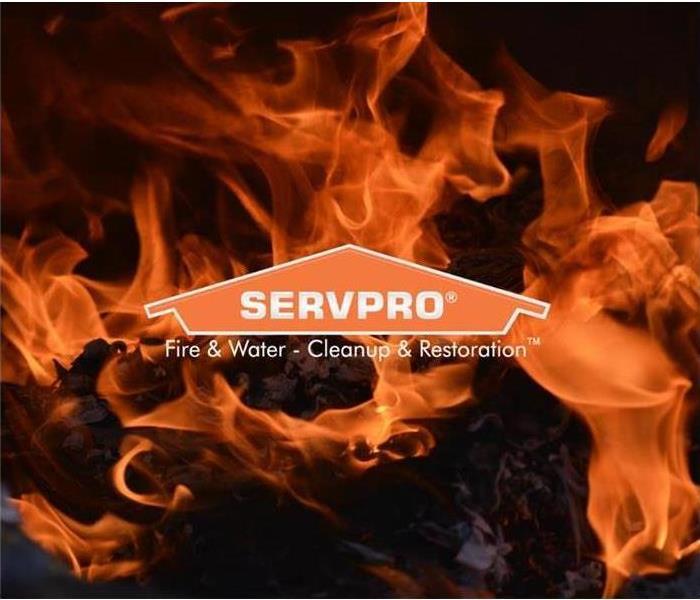 Fire damage? We can help!
Fire damage? We can help!
Great Advice from American Red Cross!
Did you know:
- Every day 7 people die in the United States due to a home fire
- You have two minutes- that 120 seconds – to escape a home fire
- On an annual average, the Ohio Buckeye Region of the Red Cross responds to over 3 home fires per day in 45 counties!
The American Red Cross cares about your safety and encourages you to test your smoke alarms and replace your batteries as needed. This is a lifesaving action of our Home Fire Preparedness Campaign, which rallies communities across the country to protest people from these every day disasters. Don't ignore the beeping sound of batteries going dead on a fire alarm, take a few minutes and go change the batteries right away! Your safety is in your own hands!
Do I need to replace my fixtures after a fire?
8/19/2020 (Permalink)
SERVPRO Cleans and Restores All Areas of Your Home.
Dealing with the ramifications of a fire in your home can be stressful and challenging, especially when smoke residue tends to find a way on to almost every surface in your home. Cleaning is an essential component in the repair process and doing so quickly helps mitigate further damage. Our trained restoration specialists may need to remove your personal belongings to best clean your home. However, fixtures and other structural elements also need thorough cleaning.
Does SERVPRO remove the fixtures to clean them?
Technicians Restore Structural Elements in Your Home.
Cleaning everything in your fire-damaged home is crucial for a complete restoration. An often-overlooked part of your home is the fixtures like lighting, faucets, and doorknobs. Typically, our fire restoration team can clean fixtures without having to relocate them from your house. One exception may be intricately designed chandeliers since they may need detailed, precise cleaning and are very delicate. After cleaning, our team also makes sure that moving components work properly using silicone spray.
How Do Technicians Clean Lighting Fixtures?
- They are usually cleaned with the ceiling.
- Carefully around and behind fixtures to remove all residue.
- Hand, steam, or submerge clean delicate fixtures.
How Do Technicians Clean Bathroom and Kitchen Fixtures?
- Identify the level of residue.
- The technicians usually wet clean using the appropriate type of cleaning product for the material in question.
- After cleaning, fixtures may require a lubricating silicone spray such as WD-40 to restore appropriate movement.
For 24/7 assistance in restoring your home after a fire, contact SERVPRO of Farmington at (573) 756-5191. We make it, "Like it never even happened."
Q & A Regarding House Fires
8/19/2020 (Permalink)
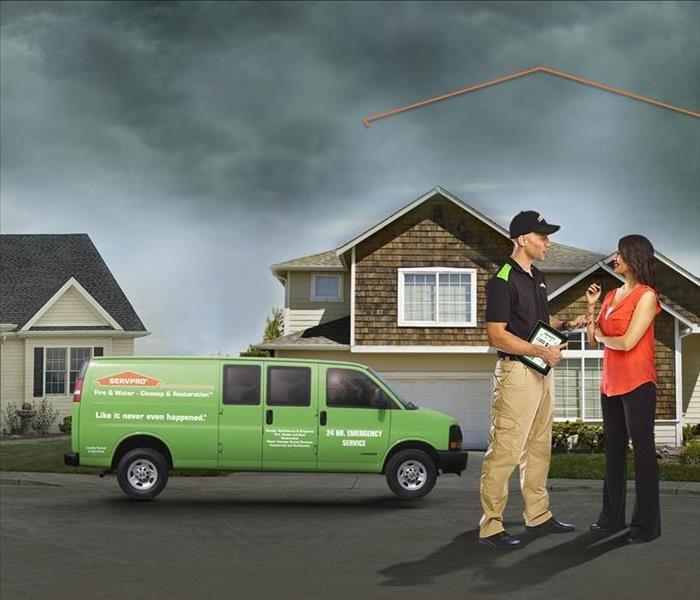 Let us take care of you!
Let us take care of you!
We understand the stress and worry a homeowner may feel following a fire event in their home. Our fire damage restoration team has the knowledge and experience to help ease your worries during the restoration process. We do this every day and our purpose is to not only make it "Like it never even happened," but also to be a resource for your during the claims process. Below are some frequently asked questions during the beginning of the claims process.
How long will this take?
A complete recovery from a fire event at your home or business can take weeks or months depending on how extensive the damage is. How badly was the property’s structure affected? Does the roof need to be repaired? How much of the structure needs to be removed and replaced? The answers to these questions and several others will determine a clearer project timeline. Before beginning the restoration process, we will give you an estimated project completion date and update you along the way if any changes need to be addressed.
How do you determine what was affected by the fire?
The fire may have been contained to one room in your home or business, but soot can travel via your air conditioning system to several other areas throughout the property. Soot is often hard to detect with the naked eye, but with time acidic soot will lead to discoloration and erosion of materials. Our technicians will utilize dry sponges to test areas in your home or business for hard to see soot. Therefore, if soot is discovered in a certain room, then the structure and contents of that room must be cleaned.
How much will this cost? How do you write the estimate?
We use Xactimate to create our estimates. Xactimate is a software program used by all insurance companies for restoration project estimation. The prices for each line item are set within the program and accepted by insurance companies. All estimates include labor, time, and materials required. Again, we will send final estimate and any required supplements directly to your insurance company. The estimation process is exceptionally detailed, tedious, and dependent upon services rendered. A conclusive estimate can only be completed once the project is finished due to the nature of the restoration process.
What is subrogation?
Subrogation occurs when the insurance company believes a third-party is responsible for the damages and seeks legal action to recover costs for the claim. When subrogation is necessary, the insurance company may not allow anyone to work in the affected area while the investigation is pending. The investigation process may greatly affect our ability to perform services and extend the projected completion date. Our team will have no control over this. Please refer to your insurance company for any questions regarding subrogation.
What should I do now?
If an insurance claim has not already been opened, then calling your insurance company and doing so is the first step. Request a copy of your insurance policy declaration page from your insurance agent or claims specialist to review your coverage. Learn how much coverage you have for structure (labeled dwelling) and for contents. You may need to find another place to stay during the cleaning process. Read your policy or ask your insurance agent to help you understand what is covered under the additional living expenses (ALE) or “loss of use” section in your policy. Ask your insurance company to give you a list in writing of what is commonly covered under these sections. We are not your insurance company and do have any control over your policy limits.
How do I know which items can or cannot be cleaned?
Our technicians will help you understand which items are generally able to be cleaned after a fire and which items we suggest discarding of. Some insurance companies may not be willing to pay for our team to create an inventory list of your contents. If your insurance company will not cover the expense of our team inventorying your contents, then we will help instruct you as best as we can. You will want to create a list of all items that need to be discarded and take pictures of each item. Depending on your policy, your insurance company will either pay for the replacement cost of the items or an actual cash value. It will be your responsibility to negotiate an amount for your contents with your insurance company. One tip is to take the list of items needing to be replaced to a large box store and create a registry to show the total of those items.
What is the adjuster’s role in this process?
The adjuster assigned to your claim is working for the insurance company either as an employee or a hired contractor through a third-party claim management company. The adjuster will create an estimate of the needed repairs and your claim will be awarded that amount. We will communicate our restoration plan and share any suggestions or necessary supplements with the adjuster.
Who can help with the rebuild portion of my claim?
Our purpose as your trusted restoration vendor is to clean and/or remove materials affected by the claimed event. We work to mitigate damages to prevent any further damages from occurring in a timely and cost-efficient manner. We are only allowed to remove what is necessary for proper mitigation. Restoration and rebuild are two separate portions of your claim. Following our cleaning process, we can rebuild the affected structure and/or areas. We will schedule the rebuild with our Reconstruction Department.
To learn more about our fire restoration process or for assistance with your home, please send an email to Megan at mjacobs@SERVPRO9766.com.
Saving Lives: One Smoke Detector at a Time
8/18/2020 (Permalink)
One small device can save lives? YES!
Make sure you replace the batteries in your smoke detector regularly to ensure it works because it could save your life!
According to The American Red Cross:
- 7 people die daily in a house fire
- Every 40 minutes a fire injury is reported
- $7 billion in property damage every year
The National Fire Protection Association strongly suggests installing a smoke alarm in every bedroom of your home. They also highly recommend installing a smoke detector outside every sleeping area and on every level of your home. If your home is larger, you may need more smoke alarms to ensure you will be alerted when the smoke hits the detector.
Today, many home security systems offer a smoke detector option that will contact your local fire department in the event of smoke detection. This is a wonderful safety tool, especially if you aren't home or are sleeping heavily at the time of a fire occurrence.
In the event of a house fire big or small, make sure you call SERVPRO of Farmington for your clean up needs.
Also, you can contact your local Red Cross Chapter to help assist with adjusting if you have been temporarily put out.
Fire Restoration Process
8/17/2020 (Permalink)
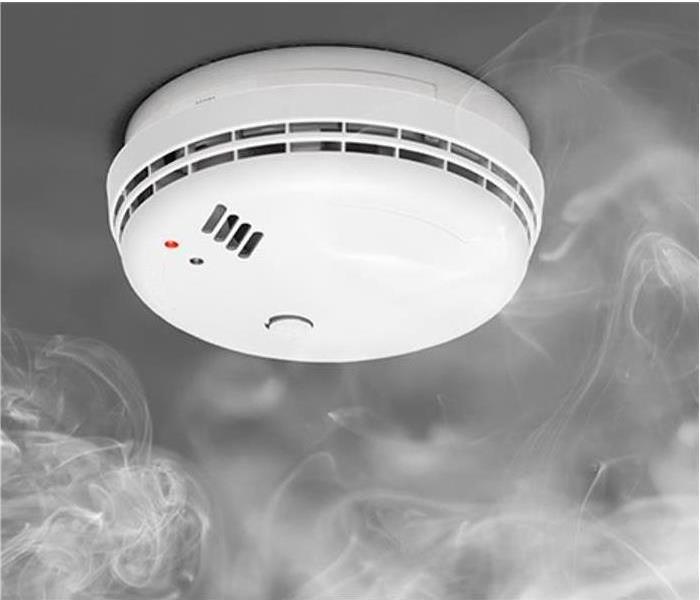 Fire damage is our specialty. Call us anytime at 573-756-5191.
Fire damage is our specialty. Call us anytime at 573-756-5191.
When it comes to fire damage, preparation is the key.
The first 48 hours after a fire often can be the difference between "restoring" vs. "replacing" your property and/or personal items. SERVPRO of Farmington provides timely response with restoration services ranging from fire, smoke, and soot removal, to content claims inventory and document restoration.
If you have experienced fire damage in your home or business, here is what to expect from us:
One Hour: Within one hour from notice of loss, a priority responder will contact you.
Four Hours: Within four hours of loss notification, our certified technicians will be onsite to assess the damage.
Eight Hours: Within eight hours of on-site arrival, certified technicians will be working neatly and efficiently to clean, restore, and deodorization. Pre-cleaning for restoration, to prevent any further damage from soot and smoke.
Detailed Explanation: A trained and uniformed technician will walk you through the job process step-by-step, explaining what to expect and the anticipated outcome. We then use state-of-the-art restoration techniques to ensure your home or business is back to normal in an appropriate time frame.
Final Walk-through: After the work has been completed, a final walk-through will be conducted with you to help ensure your satisfaction.
Fire, Smoke, Soot Damage
8/13/2020 (Permalink)
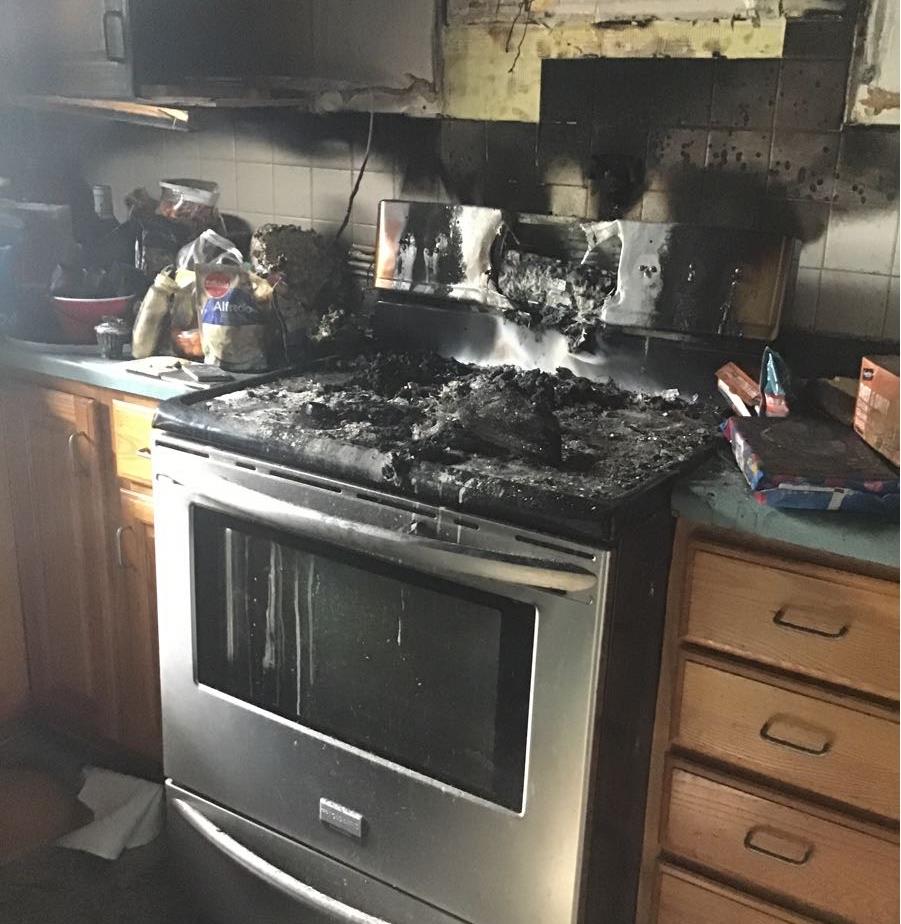 This fire was caused due to a stove malfunction.
This fire was caused due to a stove malfunction.
It goes everywhere. Smoke and soot are extremely invasive and can penetrate various cavities within your home, causing hidden damage and odor. Our smoke damage expertise and experience allow us to inspect and accurately assess the extent of the damage to develop a comprehensive plan of action.
Did you know? Here are some facts about smoke and soot:
Hot smoke migrates to cooler areas and upper levels of a structure.
Smoke flows around plumbing systems, seeping through the holes used by pipes to go from floor to floor.
The type of smoke may greatly affect the restoration process.
Different Types of Smoke
There are two different types of smoke–wet and dry. As a result, there are different types of soot residue after a fire. Before restoration begins, SERVPRO of Farmington will test the soot to determine which type of smoke damage occurred.
The cleaning procedures will then be based on the information identified during pretesting. Here is some additional information:
Wet Smoke – Plastic and Rubber
Low heat, smoldering, pungent odor, sticky, smeary. Smoke webs are more difficult to clean.
Dry Smoke – Paper and Wood
Fast burning, high temperatures, heat rises therefore smoke rises.
Protein Fire Residue – Produced by evaporation of material rather than from a fire
Virtually invisible, discolors paints and varnishes, extreme pungent odor.
Our Fire Damage Restoration Services
Since each smoke and fire damage situation is a little different, each one requires a unique solution tailored for the specific conditions. We have the equipment, expertise, and experience to restore your fire and smoke damage. We will also treat your family with empathy and respect and your property with care.
Have Questions about Fire, Smoke, or Soot Damage?
Call Us Today – 573-756-5191
Fire Damage=Immediate Attention
9/16/2019 (Permalink)
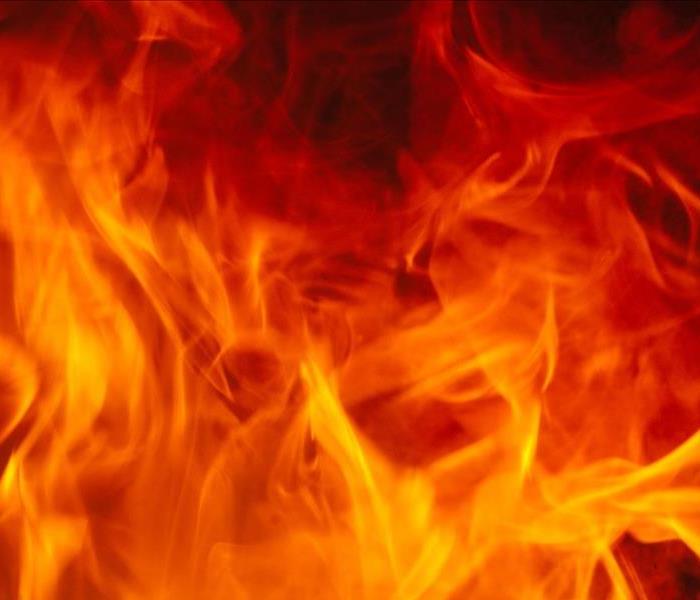 Fire Damage? We can help! Call us anytime at 573-756-5191.
Fire Damage? We can help! Call us anytime at 573-756-5191.
Fire Damage In Your Home or Business Requires Immediate Attention
Events leading to a fire can have many different factors. Even a prevention plan for fire will only reduce the risk of fire, it will not eliminate the potential of a fire hazard. There are ways to limit the possibility of fire. One method is to keep smoking restricted to designated areas. These selected areas also need maintenance to lower the chance of fire damage. In most cases, the preferable area for smoking is outside. Also, electrical wiring should be installed in compliance with OSHA regulations and local codes. Licensed electricians should be the ones to do the maintenance. Other aspects of the home like fuel gas and appliances that produce heat should be up to standard.
Experiencing a fire in your home or business can be devastating. You don't want to be complacent about taking care of the fire damage. It is imperative to make sure that you react to the necessary cleanup which has resulted from the flame out. In most cases, you are going to need a professional to take care of the fire damage so that you can be sure that your house will not be vulnerable to on-going problems.
Fire Damage is something that needs to be quickly and thoroughly cleaned up and fixed by professionals from SERVPRO of Farmington. Even after taking care of the fire, it is important to look for any additional damage that may have occurred. Long after the fire is out, certain forms of damage could become visible such as cracked foundations, contamination, toxic fumes, leaking pipes from the heat, or even mold growth. For this reason, it is critical to making sure that every bit of moisture or damage is found in the home and repaired.
By hiring an experienced team of skilled fire damage restoration technicians, you can be assured that these IICRC trained individuals will utilize industry leading equipment to mitigate the harm caused by the inferno. Fast response to limit secondary water damage resulting from the firefighters' efforts to extinguish the flames is of paramount importance. Our expert service technicians arrive promptly after you call SERVPRO of Farmington at 573-756-5191.
Commercial Fire? We can handle it!
9/16/2019 (Permalink)
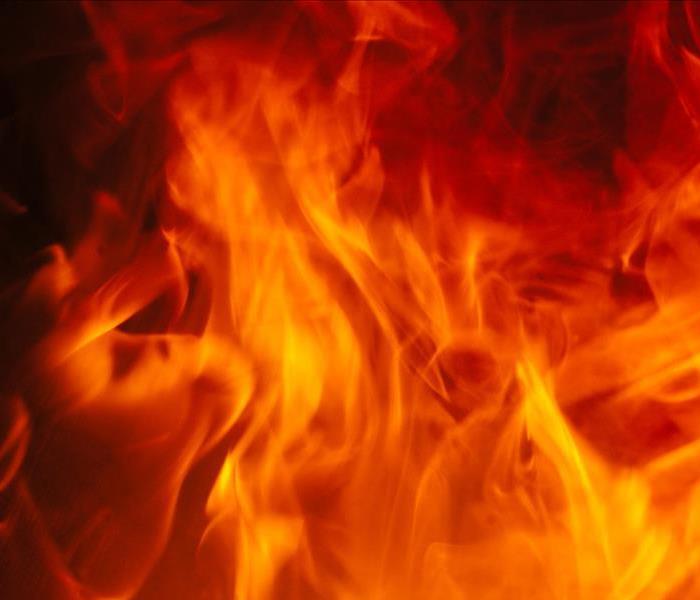 Commercial fire? No problem. Call us at 573-756-5191.
Commercial fire? No problem. Call us at 573-756-5191.
When a fire strikes your commercial property, it's quite likely that you feel yourself start to panic. This immediate reaction makes sense given all the economic turmoil and property destruction that a fire can cause. However, knowing which steps to take in the face of a commercial fire can help prevent you from becoming anxious, losing money, and undergoing extensive property damages. To handle a commercial fire successfully and speedily, implement the following four tips:
Contact A Fire Remediation Expert.
Once the fire department has doused all the flames, be sure to call a fire remediation expert. This individual will be able to equip you with a thorough assessment indicating the extent of the damages. Don't ever attempt to handle any of the cleanups, drying, or restoration processes on your own. Doing so could put you in peril of injury and illness.
Assemble Your Records.
In addition to contacting a fire remediation expert, make sure that you assemble your business' essential records. You'll want to have this information with you when you start working with your insurance company. To guarantee that you can have all your files ready in a safe place, make a point to buy a fireproof safe where they can be stored.
Call The Insurance Company Immediately.
Be sure that you call your insurance company once the fire is put out. This step is important because your insurance agent will work with you to file a claim and determine how much coverage you'll attain for the commercial damages.
Get Permission To Reenter The Building.
Always ask the fire department or another local authority whether you can reenter your building. In some cases, fires can weaken the structural integrity of the commercial property and make it subject to collapse. Therefore, you need to assure that reentry is safe for you and your employees.
Call SERVPRO For Fast, Friendly Fire Remediation Services
If your business caught on fire, don't worry. Instead, call the professionals at SERVPRO of Farmington and let us start cleaning up immediately. Acting right now is the key to limiting damages and expediting the restoration process. Choosing our team of industry specialists is the secret to attaining the sophisticated services you deserve. All our IICRC-certified technicians will work with diligence and determination to get your commercial property back in pristine condition, so call us now at 573-756-5191.
Locally Owned Company with National Resources
As a locally owned and operated business, SERVPRO of Farmington is strategically located to respond quickly to your commercial fire emergency event. When commercial fire damage occurs, we have the resources and personnel to help. Call us today! 573-756-5191.
Pets & Fire Damage
8/20/2019 (Permalink)
Pets are family, too!
At any given moment, a fire emergency can take place in our servicing areas, and though unexpected; it can be instrumental to already have a strategy in place for everyone, pets included, in your home to evacuate and meet in a safe location. While you should always be most focused on keeping yourself and your family safe, you can be better prepared to keep your pets safe during a fire emergency by following these safety tips:
Practice Evacuating
In the confusion and fear caused by a fire, it can be hard to think of everything you need to do at that moment. If you already have a plan in place and practice it a couple of times, you can be more prepared to handle a fire emergency. This can not only be helpful for pet safety, but also for the safety of everyone in your household.
Notice Your Pets Location
An important part of the planning process can be knowing where your pets spend most of their time. It can be especially helpful to take note where they hide when frightened, maybe during a thunder or lightning storm. You don’t want to put yourself or your family at risk by spending too much time searching for your dog or cat during a fire emergency.
Keep Any Collars and Leashes Nearby
Fire emergencies can be especially frightening to pets. By keeping their collars, leashes, or carriers handy, you can more easily lead them safely out of the house. If you are unable to find your pets, it can be easier for the fire department to get them out if they are wearing collars. It can be a good idea to hang leashes by the door that you are planning to evacuate through.
Have Fire Damage? Call Us Today 573-756-5191.
Cooking Fire
8/20/2019 (Permalink)
Cooking is one of the leading causes of house fires in the United States. Often, cooking fires are ignited by grease, which can be dangerous for both your home and the individuals inside your home. To keep everyone safe, here are our tips for safely containing and putting out grease fires in your kitchen:
- DO NOT USE WATER! Trying to extinguish a grease fire with water can be catastrophic. Also stay away from flour, baking powder, or any other cooking powders that resemble baking soda or salt. While baking soda and salt can help (we’ll touch on this later), powders that merely look like them can have very different chemical makeup and will not react well to the grease. They can make the fire worse.
- Cover the flames with a metal lid or cookie sheet. Do not remove cover until it has cooled. This will help contain the fire and suffocate the flames.
- TURN OFF the heat source! When a grease fire starts, heat fuels it and can make the flames spread and grow stronger. Turning off the heat will cut that main source of fuel.
- Here’s where the salt and baking soda come in. If possible, pour some salt or baking soda onto the fire – the substances will help smother the flame and significantly reduce its strength.
- If none of the previous steps are successful in putting out the grease fire, spray the fire with a Class B Dry Chemical Fire Extinguisher.
An important note - IF YOU ARE UNABLE TO EXTINGUISH THE GREASE FIRE, GET OUT. Please keep in mind that your safety and the safety of those around you is most important. A grease fire can become very dangerous very quickly. Evacuate, and once everyone is safely out of harm’s way, call 911. Do not re-enter your home until the fire has been contained by firefighters.
If your home is damaged by grease fire or any other type of disaster, SERVPRO of Farmington is ready to help with the restoration process. Give us a call at 573-756-5191.
Fire Damage? Call us!
8/19/2019 (Permalink)
Fire Damage Cleanup and Restoration Includes Mitigating Aspects You Cannot See
The amount of soot covering every surface near where a fire happened might provide a hint of the odors your family might experience without proper and complete mitigation of all the changes that took place in your business or home. Heat changes things chemically, meaning not all the changes show up to the naked eye.
When your business or home sustains fire damage, you need to consider the invisible changes. They can make your business or home uncomfortable and possibly cause occupants unwanted health effects. At SERVPRO, we understand the causes behind such risks, and the methods needed to rid your property of them, as well.
Electrical outlets in the structure can sustain damage within the walls, even when no other damage to those walls seems apparent. This can happen not only because of the water used to put the fire out but also because of the heat. When smoke gets pushed around by the air currents, it also gets into the cavities within walls, under cabinets, and other dead spaces. Outlets that no longer work are only one aspect of fire damage.
When the hot smoke gets into the hollow spaces in your house, it does not leave. Instead, it settles on the sides and bottom of the area where it got trapped. Smoke contains not only gases from the things that burned but also solid particles. These make up most of the soot you find, and it is also where most of the odors you smell in a home with fire damage.
We can discuss with you the best methods to get rid of the odors in the structure. While we use air scrubbers to clean the air while we work, we can strengthen the effect of this by fogging the home so the mist bonds with these hidden smoke particles. Once bonded, the number of particles that make their way back into the air drastically diminish because they no longer disintegrate into small enough pieces.
Our experience in eliminating the unseen problems of odor-causing soot from hidden spaces leaves our customers' structure not only looking “Like it never even happened,” but also smelling like a fire never occurred.
SERVPRO of Farmington wants to help you recover faster from fire damage by mitigating your fire damage. This includes odors that do not go away without direct mitigation of the problem. Call 573-756-5191 to do more than mask the problem.
Smoke Detector: Which one to buy?
8/19/2019 (Permalink)
In Order to Find the Right Alarm, You Need to Know the Various Types
Finding the right smoke detector for your home is a key part of fire safety. If your home does not have the proper smoke alarm, your house could sustain severe fire damage and require a major fire cleanup.
In order to choose the right alarm, you need to know the various types. They include:
- Combination
- Photoelectric
- Ionization
- Dual sensor
Combination Alarm
A combination alarm typically includes both smoke and carbon monoxide detectors. Because carbon monoxide sensors don’t last as long as smoke ones, combination alarms need to be replaced more frequently. However, they are great for homes that include an attached garage or fuel-burning appliances.
Photoelectric Alarm
A photoelectric alarm is ideal for detecting slow-burning fires, specifically electric fires or those in clothes and bedding. These detectors are less likely to go off accidentally, but they can be more expensive.
Ionization Alarm
An ionization smoke alarm detects small particles from quickly igniting fires such as those caused by grease or paper. Since they are sensitive, you may want to avoid using them near kitchens.
Dual-Sensor Alarm
As its name implies, a dual-sensor alarm uses parts of both ionization and photoelectric smoke detectors. They can be costly, but they also provide great protection for the entire home.
There are several other factors you should consider when choosing a detector. If you don’t want to climb a ladder to test the battery every month, look for a device that can be tested via remote control. You may also want to choose a detector that is easy to clean.
Buying the right detector and regularly checking the batteries will help keep your loved ones safe in the event of a fire. The beeping smoke alarm should alert you to the presence of a fire before it spreads.
Educating Kids About Fire Safety
9/18/2018 (Permalink)
Fire Prevention Week was established to remember the Great Chicago Fire of 1871, which began on October 8. Use these worksheets, activities, and lessons to teach your students/child(ren) about fire safety and prevention. Prepare your students/child(ren) for emergency situations with worksheets and literature on fire readiness. October is Fire Prevention Month, but any time of the year is appropriate to enjoy these resources.
Please visit: https://www.teachervision.com/emergency/teacher-resources/47554.html
1. Go to a firefighter in an emergency. Young children may be scared the first time they see a firefighter in full gear. Explain to children
- What firefighters wear and why.
- How a firefighter can help if there is a fire.
Contact your local fire station to arrange a tour. The children can learn about equipment and become familiar with what firefighters look like and what they do. Or invite firefighters to your classroom so they can put on their gear in front of the children, explain their jobs, and answer children’s questions.
2. Crawl low under smoke.
- Tell children that some fires make lots of smoke, which is dangerous to breathe.
- Show them the safe way to respond when a room fills with smoke: get down on your hands and knees, keep your head up, and crawl outside.
- Ask children to practice with you. Lead them in crawling across the room with their heads up. Repeat frequently to help children remember this important safety strategy.
3. Stop, drop, and roll. When children’s clothes catch fire, their first reaction may be to run. This can make the fire spread faster. Show children the safest way to respond:
- Stop, cover your face, get down on the ground, and roll from side to side until you smother the fire.
- Ask children to practice with you a few times and then split them into pairs. Children can take turns demonstrating to their partners. Repeat frequently to help children learn to stop, drop, and roll automatically.
4. Tell a grown-up. Emphasize to children that matches and lighters are tools that only adults use.
- Tell children that they should not play with or even touch these materials.
- Explain that if they find a match or lighter, they should tell a grown-up immediately.
- Role-play with children in small groups about what to do when they find these types of materials.
Visit www.playsafebesafe.com to learn about the play safe! be safe!program workshops, access free activities for children, and order a low-cost multimedia kit that includes a teacher manual and a DVD with fire-safety lessons.
Planning for a Fire
9/18/2018 (Permalink)
Did you know that if a fire starts in your home, you'll have just two minutes to escape? That's why it's important to have working smoke alarms in your home, develop an escape plan and practice that plan. Practice your plan until everyone in the household can evacuate in less than two minutes. Test smoke alarms every month and replace the batteries as needed. Consider placing escape ladders in rooms on upper floors. Identify two exits from every room. Install smoke alarms on every level of the home, including inside and outside each bedroom and in the basement.
Tips for creating and practicing your escape plan:
- Everyone in your household should know two ways to escape from each room in your home.
- Decide where to meet once you get outside.
- If a fire starts, you may have just two minutes to get to safety. So time your fire drills and find out: what’s your escape time?
- Smoke is dangerous. Practice low crawling.
- Teach household members what to do if their clothes catch fire: stop, drop and roll.
Animals & Fires
8/15/2018 (Permalink)
This information was developed by the U.S. Department of Homeland Security in consultation with: American Kennel Club, The American Society for the Prevention of Cruelty to Animals, American Veterinary Medical Association, and The Humane Society of the U.S, and SERVPRO.
If you are like millions of animal owners nation wide, your pet is an important member of your household. The likelihood that you and your animals will survive an emergency such as fire or flood, tornado, or terrorist attack depends largely on emergency planning done today. Some of the things you can do to prepare for the unexpected, such as assembling an animal emergency supply kit and developing a pet care buddy system, are the same for emergency. Whether you decide to stay put in an emergency or evaluate to a safer location, you will need to make plans in advance for your pets. Keep in mind that what's best for you is typically what's best for your animals.
If you must evacuate, take your pets with you if possible. However, if you are going to a public shelter, it is important to understand that animals may not be allowed inside. Plan in advance for shelter alternatives that will work for both you and your pets.
Make a back-up emergency plan in case you can't care for your animals yourself. Develop a buddy system with neighbors, friends, and relatives to make sure that someone is available to care for or evacuate your pets if you are unable to do so. Be prepared to improvise and use what you have on hand to make it on your own for at least three days, maybe longer. Preparing for the unexpected makes sense. Get ready now.
1. Prepare: Get a Pet Emergency Supply Kit
Just as you do with your family's emergency supply kit,think first about the basics for survival, particularly food and water. Consider two kits. In one, put everything you and your pets will need to stay where you are. The other should be a lightweight, smaller version you can take with you if you and your pets have to get away. Plus, be sure to review your kits regularly to ensure that their contents, especially foods and medicines, are fresh.
Food. Keep at least three days of food in an airtight, waterproof container.
Water. Store at least three days of water specifically for your pets in addition to water you need for yourself and your family. Medicines and medical records. Keep an extra supply of medicines your pet takes on a regular basis in a waterproof container.
First aid kit. Talk to your veterinarian about what is most appropriate for your pet's emergency medical needs. Most kits should include cotton bandage rolls, bandage tape and scissors; antibiotic ointment; flea and tick prevention; latex gloves, isopropyl alcohol and saline solution. Include a pet first aid reference book.
Collar with 10 tag, harness or leash. Your pet should wear a collar with its rabies tag and identification at all times. Include a backup leash, collar and 10 tag in your pet's emergency supply kit. In addition, place copies of your pet's registration information, adoption papers, vaccination documents and medical records in a clean plastic bag or waterproof container and also add them to your kit. You should also consider talking with your veterinarian about permanent identification such as microchipping, and enrolling your pet in a recovery database.
Crate or other pet carrier. If you need to evacuate in an emergency situation take your pets and animals with you provided that it is practical to do so. In many cases, your ability to do so will be aided by having a sturdy, safe, comfortable crate or carrier ready for transporting your pet. The carrier should be large enough for your pet to stand, turn around and lie down. Sanitation. Include pet litter and litter box if appropriate, newspapers, paper towels, plastic trash bags and household chlorine bleach to provide for your pet's sanitation needs. You can use bleach as a disinfectant (dilute nine parts water to one part bleach), or in an emergency you can also use it to purify water. Use 16 drops of regular household liquid bleach per gallon of water. Do not use scented or color safe bleaches, or those with added cleaners.
A picture of you and your pet together. If you become separated from your pet during an emergency, a picture of you and your pet together will help you document ownership and allow others to assist you in identifying your pet. Include detailed information about species, breed, age, sex, color and distinguishing characteristics.
Familiar items. Put favorite toys, treats or bedding in your kit. Familiar items can help reduce stress for your pet.
2. Plan What You Will Do in an Emergency
Be prepared to assess the situation. Use whatever you have on hand to take care of yourself and ensure your pet's safety during an emergency. Depending on your circumstances and the nature of the emergency the first important decision is whether you stay put or get away. You should understand and plan for both possibilities. Use common sense and the information you are learning here to determine if there is immediate danger. In any emergency, local authorities mayor may not immediately be able to provide information on what is happening and what you should do. However, watch TV, listen to the radio or check the Internet for instructions. If you're specifically told to evacuate, shelter-in-place or seek medical treatment, do so immediately.
Create a plan to get away. Plan how you will assemble your pets and anticipate where you will go. If you must evacuate, take your pets with you if practical. If you go to a public shelter, keep in mind your animals may not be allowed inside. Secure appropriate lodging in advance depending on the number and type of animals in your care. Consider family or friends willing to take in you and your pets in an emergency. Other options may include: a hotel or motel that takes pets or a boarding facility, such as a kennel or veterinary hosp ital that is near an evacuation facility or your family 's meeting place. Find out before an emergency happens if any of these facilities in your area might be viable options for you and your pets.
Develop a buddy system. Plan with neighbors, friends or relatives to make sure that someone is available to care for or evacuate your pets if you are unable to do so. Talk with your pet care buddy about your evacuation plans and show them where you keep your pet's emergency supply kit. Also designate specific locations , one in your immediate neighborhood and another farther away, where you will meet in an emergency.
Talk to your pet's veterinarian about emergency planning. Discuss the types of things that you should include in your pet's emergency first aid kit. Get the names of vets or veterinary hospitals in other cities where you might need to seek temporary shelter. You should _---","!A also consider talking with your veterinarian about permanent identification such as microchipping, and enrolling your pet in a recovery database. If your pet is microchipped, keeping your emergency contact information up to date and listed with a reliable recovery database is essential to your being reunited with your pet.
Gather contact information for emergency animal treatment. Make a list of contact information and addresses of area animal control agencies including the Humane Society or SPCA, and emergency veterinary hospitals. Keep one copy of these phone numbers with you and one in your pet's emergency supply kit. Obtain "Pets Inside" stickers and place them on you r doors or windows, including information on the number and types of pets in your home to alert firefighters and rescue workers. Consider putting a phone number on the sticker where you could be reached in an emergency. And , if time permits , remember to write the words "Evacuated with Pets" across the stickers, should you flee with your pets.
3. Stay Informed Know About Types of Emergencies
Some of the things you can do to prepare for the unexpected, such as assembling an emergency supply kit for yourself, your family and your pets , is the same regardless of the type of emergency. However, it's important to stay informed about what might happen and know what types of emergencies are likely to affect your region as well as emergency plans that have been established by your state and local government. For more information about how to prepare , visit www.ready.gov or call 1-800-BE-READY. Be prepared to adapt this information to your personal circumstances and make every effort to follow instructions received from authorities on the scene. With these simple preparations, you can be ready for the unexpected. Those who take the time to prepare themselves and their pets will likely encounter less difficulty, stress and worry. Take the time now to get yourself and your pet ready.
The New School Year & Fire Safety
8/15/2018 (Permalink)
Fire Safety and Prevention Teacher and Parent Resources
Fire Prevention Week was established to remember the Great Chicago Fire of 1871, which began on October 8. Use these worksheets, activities, and lessons to teach your students/child(ren) about fire safety and prevention. Prepare your students/child(ren) for emergency situations with worksheets and literature on fire readiness. October is Fire Prevention Month, but any time of the year is appropriate to enjoy these resources.
Please visit: https://www.teachervision.com/emergency/teacher-resources/47554.html
1. Go to a firefighter in an emergency. Young children may be scared the first time they see a firefighter in full gear. Explain to children
- What firefighters wear and why.
- How a firefighter can help if there is a fire.
Contact your local fire station to arrange a tour. The children can learn about equipment and become familiar with what firefighters look like and what they do. Or invite firefighters to your classroom so they can put on their gear in front of the children, explain their jobs, and answer children’s questions.
2. Crawl low under smoke.
- Tell children that some fires make lots of smoke, which is dangerous to breathe.
- Show them the safe way to respond when a room fills with smoke: get down on your hands and knees, keep your head up, and crawl outside.
- Ask children to practice with you. Lead them in crawling across the room with their heads up. Repeat frequently to help children remember this important safety strategy.
3. Stop, drop, and roll. When children’s clothes catch fire, their first reaction may be to run. This can make the fire spread faster. Show children the safest way to respond:
- Stop, cover your face, get down on the ground, and roll from side to side until you smother the fire.
- Ask children to practice with you a few times and then split them into pairs. Children can take turns demonstrating to their partners. Repeat frequently to help children learn to stop, drop, and roll automatically.
4. Tell a grown-up. Emphasize to children that matches and lighters are tools that only adults use.
- Tell children that they should not play with or even touch these materials.
- Explain that if they find a match or lighter, they should tell a grown-up immediately.
- Role-play with children in small groups about what to do when they find these types of materials.
Visit www.playsafebesafe.com to learn about the play safe! be safe!program workshops, access free activities for children, and order a low-cost multimedia kit that includes a teacher manual and a DVD with fire-safety lessons.
Do's and Don'ts: Fires
8/15/2018 (Permalink)
Most people think that they can clean up the mess after a fire occurs. In fact cleaning yourself without the proper tools can actually make matter worse. SERVPRO of Farmington has all the tools to help you get your home or business "Like it never even happened." Down below are the do's and don't's after a fire. Following these do's and don't's will help restore your valuables as best as possible
What to Do After a Fire
- Limit movement in the home to prevent soot particles from being embedded into upholstery and carpets.
- Keep hands clean so as not to further soil upholstery, walls and woodwork.
- Place clean towels or old linens on rugs, upholstery and carpet traffic areas.
- If electricity is off, empty freezer and refrigerator and prop doors open.
- Clean and protect chrome with light coating of petroleum jelly or oil.
- Wash houseplants on both sides of leaves.
- Tape double layers of cheesecloth over air registers.
What NOT To Do After a Fire
- Don't attempt to wash any walls or painted surfaces or shampoo carpet or upholstery without contacting us.
- Don't attempt to clean any electrical appliances that may have been close to fire, heat or water without consulting an authorized repair service.
- Don't use any canned or packaged food or beverages that may have been stored near the fire, heat or water.
- Don't turn on ceiling fixtures if ceiling is wet. The wiring may be damaged.
Don't send garments to an ordinary dry cleaner. Improper cleaning may set smoke odor. Our crews at SERVPRO of Farmington have the right knowledge and equipment to clean all of your valuables the right way with out causing damage.
Our Fire Services
8/15/2018 (Permalink)
Smoke and soot facts:
- Hot smoke migrates to cooler areas and upper levels of a structure.
- Smoke flows around plumbing systems, seeping through the holes used by pipes to go from floor to floor.
- The type of smoke many greatly affect the restoration process.
Different Types of Smoke
There are two different types of smoke- wet and dry. As a result, there are different types of soot residue after a fire. Before restoration begins, SERVPRO of Farmington will test the soot to determine which type of smoke damage occurred. The cleaning procedures will then be based on the information identified during pretesting. Here is some additional information:
Wet Smoke- Plastic and Rubber
- Low heat, smoldering, pungent odor, sticky, smeary. Smoke webs are more difficult to clean.
Dry Smoke- Paper and Wood
- Fast burning, high temperatures, heat rises therefore smoke rises.
Protein Fire Residue- Produced by evaporation of material rather than from a fire
- Virtually invisible, discolors paints and varnishes, extreme pungent odor.
Our Fire Damage Restoration Services
Since each smoke and fire damage situation is a little different, each one requires a unique solution tailored for the specific conditions. We have the equipment, expertise, and experience to restore your fire and soot damage. We will also treat your family with empathy and respect and your property with care.
Have Questions about Fire, Smoke, or Soot Damage?
Call Us Today- 573-756-5191
Keep Your Pets Safe!
2/26/2018 (Permalink)
This information was developed by the U.S. Department of Homeland Security in consultation with: American Kennel Club, The American Society for the Prevention of Cruelty to Animals, American Veterinary Medical Association, and The Humane Society of the U.S, and SERVPRO.
If you are like millions of animal owners nation wide, your pet is an important member of your household. The likelihood that you and your animals will survive an emergency such as fire or flood, tornado, or terrorist attack depends largely on emergency planning done today. Some of the things you can do to prepare for the unexpected, such as assembling an animal emergency supply kit and developing a pet care buddy system, are the same for emergency. Whether you decide to stay put in an emergency or evaluate to a safer location, you will need to make plans in advance for your pets. Keep in mind that what's best for you is typically what's best for your animals.
If you must evacuate, take your pets with you if possible. However, if you are going to a public shelter, it is important to understand that animals may not be allowed inside. Plan in advance for shelter alternatives that will work for both you and your pets.
Make a back-up emergency plan in case you can't care for your animals yourself. Develop a buddy system with neighbors, friends, and relatives to make sure that someone is available to care for or evacuate your pets if you are unable to do so. Be prepared to improvise and use what you have on hand to make it on your own for at least three days, maybe longer. Preparing for the unexpected makes sense. Get ready now.
1. Prepare: Get a Pet Emergency Supply Kit
Just as you do with your family's emergency supply kit,think first about the basics for survival, particularly food and water. Consider two kits. In one, put everything you and your pets will need to stay where you are. The other should be a lightweight, smaller version you can take with you if you and your pets have to get away. Plus, be sure to review your kits regularly to ensure that their contents, especially foods and medicines, are fresh.
Food. Keep at least three days of food in an airtight, waterproof container.
Water. Store at least three days of water specifically for your pets in addition to water you need for yourself and your family. Medicines and medical records. Keep an extra supply of medicines your pet takes on a regular basis in a waterproof container.
First aid kit. Talk to your veterinarian about what is most appropriate for your pet's emergency medical needs. Most kits should include cotton bandage rolls, bandage tape and scissors; antibiotic ointment; flea and tick prevention; latex gloves, isopropyl alcohol and saline solution. Include a pet first aid reference book.
Collar with 10 tag, harness or leash. Your pet should wear a collar with its rabies tag and identification at all times. Include a backup leash, collar and 10 tag in your pet's emergency supply kit. In addition, place copies of your pet's registration information, adoption papers, vaccination documents and medical records in a clean plastic bag or waterproof container and also add them to your kit. You should also consider talking with your veterinarian about permanent identification such as microchipping, and enrolling your pet in a recovery database.
Crate or other pet carrier. If you need to evacuate in an emergency situation take your pets and animals with you provided that it is practical to do so. In many cases, your ability to do so will be aided by having a sturdy, safe, comfortable crate or carrier ready for transporting your pet. The carrier should be large enough for your pet to stand, turn around and lie down. Sanitation. Include pet litter and litter box if appropriate, newspapers, paper towels, plastic trash bags and household chlorine bleach to provide for your pet's sanitation needs. You can use bleach as a disinfectant (dilute nine parts water to one part bleach), or in an emergency you can also use it to purify water. Use 16 drops of regular household liquid bleach per gallon of water. Do not use scented or color safe bleaches, or those with added cleaners.
A picture of you and your pet together. If you become separated from your pet during an emergency, a picture of you and your pet together will help you document ownership and allow others to assist you in identifying your pet. Include detailed information about species, breed, age, sex, color and distinguishing characteristics.
Familiar items. Put favorite toys, treats or bedding in your kit. Familiar items can help reduce stress for your pet.
2. Plan What You Will Do in an Emergency
Be prepared to assess the situation. Use whatever you have on hand to take care of yourself and ensure your pet's safety during an emergency. Depending on your circumstances and the nature of the emergency the first important decision is whether you stay put or get away. You should understand and plan for both possibilities. Use common sense and the information you are learning here to determine if there is immediate danger. In any emergency, local authorities mayor may not immediately be able to provide information on what is happening and what you should do. However, watch TV, listen to the radio or check the Internet for instructions. If you're specifically told to evacuate, shelter-in-place or seek medical treatment, do so immediately.
Create a plan to get away. Plan how you will assemble your pets and anticipate where you will go. If you must evacuate, take your pets with you if practical. If you go to a public shelter, keep in mind your animals may not be allowed inside. Secure appropriate lodging in advance depending on the number and type of animals in your care. Consider family or friends willing to take in you and your pets in an emergency. Other options may include: a hotel or motel that takes pets or a boarding facility, such as a kennel or veterinary hosp ital that is near an evacuation facility or your family 's meeting place. Find out before an emergency happens if any of these facilities in your area might be viable options for you and your pets.
Develop a buddy system. Plan with neighbors, friends or relatives to make sure that someone is available to care for or evacuate your pets if you are unable to do so. Talk with your pet care buddy about your evacuation plans and show them where you keep your pet's emergency supply kit. Also designate specific locations , one in your immediate neighborhood and another farther away, where you will meet in an emergency.
Talk to your pet's veterinarian about emergency planning. Discuss the types of things that you should include in your pet's emergency first aid kit. Get the names of vets or veterinary hospitals in other cities where you might need to seek temporary shelter. You should _---","!A also consider talking with your veterinarian about permanent identification such as microchipping, and enrolling your pet in a recovery database. If your pet is microchipped, keeping your emergency contact information up to date and listed with a reliable recovery database is essential to your being reunited with your pet.
Gather contact information for emergency animal treatment. Make a list of contact information and addresses of area animal control agencies including the Humane Society or SPCA, and emergency veterinary hospitals. Keep one copy of these phone numbers with you and one in your pet's emergency supply kit. Obtain "Pets Inside" stickers and place them on you r doors or windows, including information on the number and types of pets in your home to alert firefighters and rescue workers. Consider putting a phone number on the sticker where you could be reached in an emergency. And , if time permits , remember to write the words "Evacuated with Pets" across the stickers, should you flee with your pets.
3. Stay Informed Know About Types of Emergencies
Some of the things you can do to prepare for the unexpected, such as assembling an emergency supply kit for yourself, your family and your pets , is the same regardless of the type of emergency. However, it's important to stay informed about what might happen and know what types of emergencies are likely to affect your region as well as emergency plans that have been established by your state and local government. For more information about how to prepare , visit www.ready.gov or call 1-800-BE-READY. Be prepared to adapt this information to your personal circumstances and make every effort to follow instructions received from authorities on the scene. With these simple preparations, you can be ready for the unexpected. Those who take the time to prepare themselves and their pets will likely encounter less difficulty, stress and worry. Take the time now to get yourself and your pet ready.
Mapping Out Your Escape Plan: Multi- Family Dwelling
9/20/2017 (Permalink)
Did you know that if a fire starts in your home, you'll have just two minutes to escape? That's why it's important to have working smoke alarms in your home, develop an escape plan and practice that plan. Practice your plan until everyone in the household can evacuate in less than two minutes. Test smoke alarms every month and replace the batteries as needed. Consider placing escape ladders in rooms on upper floors. Identify two exits from every room. Install smoke alarms on every level of the home, including inside and outside each bedroom and in the basement.
Tips for creating and practicing your escape plan:
- Everyone in your household should know two ways to escape from each room in your home.
- Decide where to meet once you get outside.
- If a fire starts, you may have just two minutes to get to safety. So time your fire drills and find out: what’s your escape time?
- Smoke is dangerous. Practice low crawling.
- Teach household members what to do if their clothes catch fire: stop, drop and roll.
Teaching Children About Fire Safety
9/20/2017 (Permalink)
Fire Safety and Prevention Teacher and Parent Resources
Fire Prevention Week was established to remember the Great Chicago Fire of 1871, which began on October 8. Use these worksheets, activities, and lessons to teach your students/child(ren) about fire safety and prevention. Prepare your students/child(ren) for emergency situations with worksheets and literature on fire readiness. October is Fire Prevention Month, but any time of the year is appropriate to enjoy these resources.
Please visit: https://www.teachervision.com/emergency/teacher-resources/47554.html
1. Go to a firefighter in an emergency. Young children may be scared the first time they see a firefighter in full gear. Explain to children
- What firefighters wear and why.
- How a firefighter can help if there is a fire.
Contact your local fire station to arrange a tour. The children can learn about equipment and become familiar with what firefighters look like and what they do. Or invite firefighters to your classroom so they can put on their gear in front of the children, explain their jobs, and answer children’s questions.
2. Crawl low under smoke.
- Tell children that some fires make lots of smoke, which is dangerous to breathe.
- Show them the safe way to respond when a room fills with smoke: get down on your hands and knees, keep your head up, and crawl outside.
- Ask children to practice with you. Lead them in crawling across the room with their heads up. Repeat frequently to help children remember this important safety strategy.
3. Stop, drop, and roll. When children’s clothes catch fire, their first reaction may be to run. This can make the fire spread faster. Show children the safest way to respond:
- Stop, cover your face, get down on the ground, and roll from side to side until you smother the fire.
- Ask children to practice with you a few times and then split them into pairs. Children can take turns demonstrating to their partners. Repeat frequently to help children learn to stop, drop, and roll automatically.
4. Tell a grown-up. Emphasize to children that matches and lighters are tools that only adults use.
- Tell children that they should not play with or even touch these materials.
- Explain that if they find a match or lighter, they should tell a grown-up immediately.
- Role-play with children in small groups about what to do when they find these types of materials.
Visit www.playsafebesafe.com to learn about the play safe! be safe!program workshops, access free activities for children, and order a low-cost multimedia kit that includes a teacher manual and a DVD with fire-safety lessons.
SERVPRO of Farmington & Fire Damage
8/22/2017 (Permalink)
Smoke and soot facts:
- Hot smoke migrates to cooler areas and upper levels of a structure.
- Smoke flows around plumbing systems, seeping through the holes used by pipes to go from floor to floor.
- The type of smoke many greatly affect the restoration process.
Different Types of Smoke
There are two different types of smoke- wet and dry. As a result, there are different types of soot residue after a fire. Before restoration begins, SERVPRO of Farmington will test the soot to determine which type of smoke damage occurred. The cleaning procedures will then be based on the information identified during pretesting. Here is some additional information:
Wet Smoke- Plastic and Rubber
- Low heat, smoldering, pungent odor, sticky, smeary. Smoke webs are more difficult to clean.
Dry Smoke- Paper and Wood
- Fast burning, high temperatures, heat rises therefore smoke rises.
Protein Fire Residue- Produced by evaporation of material rather than from a fire
- Virtually invisible, discolors paints and varnishes, extreme pungent odor.
Our Fire Damage Restoration Services
Since each smoke and fire damage situation is a little different, each one requires a unique solution tailored for the specific conditions. We have the equipment, expertise, and experience to restore your fire and soot damage. We will also treat your family with empathy and respect and your property with care.
Have Questions about Fire, Smoke, or Soot Damage?
Call Us Today- 573-756-5191
Fire Tips
8/9/2017 (Permalink)
 Call us today for all your fire redmediation needs!
573-756-5191
Call us today for all your fire redmediation needs!
573-756-5191
Most people think that they can clean up the mess after a fire occurs. In fact cleaning yourself without the proper tools can actually make matter worse. SERVPRO of Farmington has all the tools to help you get your home or business "Like it never even happened." Down below are the do's and don't's after a fire. Following these do's and don't's will help restore your valuables as best as possible
What to Do After a Fire
- Limit movement in the home to prevent soot particles from being embedded into upholstery and carpets.
- Keep hands clean so as not to further soil upholstery, walls and woodwork.
- Place clean towels or old linens on rugs, upholstery and carpet traffic areas.
- If electricity is off, empty freezer and refrigerator and prop doors open.
- Clean and protect chrome with light coating of petroleum jelly or oil.
- Wash houseplants on both sides of leaves.
- Tape double layers of cheesecloth over air registers.
What NOT To Do After a Fire
- Don't attempt to wash any walls or painted surfaces or shampoo carpet or upholstery without contacting us.
- Don't attempt to clean any electrical appliances that may have been close to fire, heat or water without consulting an authorized repair service.
- Don't use any canned or packaged food or beverages that may have been stored near the fire, heat or water.
- Don't turn on ceiling fixtures if ceiling is wet. The wiring may be damaged.
Don't send garments to an ordinary dry cleaner. Improper cleaning may set smoke odor. Our crews at SERVPRO of Farmington have the right knowledge and equipment to clean all of your valuables the right way with out causing damage.
A Once in a Lifetime Event: Solar Eclipse
8/9/2017 (Permalink)
 Call us for all of your fire restoration needs!
573-756-5191
Call us for all of your fire restoration needs!
573-756-5191
On August 21, 2017, our region will experience a total solar eclipse. This type of eclipse is when the sun, moon, and earth align so that the moon casts a shadow on the earth. We are in its direct path and will have a prime viewing opportunity.
The Great Ball of Fire
According to NinePlanets.org, the temperature of the sun’s surface is about 5800 Kelvin—or 9980 degrees Fahrenheit. That is roughly nine times hotter than the average house fire, which burns at 1100 degrees Fahrenheit, according to the National Institute of Fire and Safety Training. A lot of damage can occur at that temperature.
Here to Help
SERVPRO of Farmington is your local professional fire restoration team. When the fire trucks are gone and you find yourself stressed and confused, know that SERVPRO® is here to help. More so than even help cleaning up the fire damage, you need someone who cares for your needs during this time of crisis. We provide 24-hour emergency service so that we are there when you need us the most.
We primarily serve St. Francois County, Iron County, Madison County, Ste. Genevieve County, and Washington County, but are willing to help wherever we get called.
When the 2017 Solar Eclipse makes its way through town, remember the power of the sun, and that a fraction of that heat is all it takes to damage a home. When fire restoration is needed, call SERVPRO of Farmington and we will help make it “Like it never even happened.”
Preparing Your Pets for Emergencies Makes Sense. Get Ready Now!
3/13/2017 (Permalink)
 Millie (dog) and Dennis (cat) laying in bed at their home. Prepare for the unexpected to keep your pets safe.
Millie (dog) and Dennis (cat) laying in bed at their home. Prepare for the unexpected to keep your pets safe.
This information was developed by the U.S. Department of Homeland Security in consultation with: American Kennel Club, The American Society for the Prevention of Cruelty to Animals, American Veterinary Medical Association, and The Humane Society of the U.S, and SERVPRO.
If you are like millions of animal owners nation wide, your pet is an important member of your household. The likelihood that you and your animals will survive an emergency such as fire or flood, tornado, or terrorist attack depends largely on emergency planning done today. Some of the things you can do to prepare for the unexpected, such as assembling an animal emergency supply kit and developing a pet care buddy system, are the same for emergency. Whether you decide to stay put in an emergency or evaluate to a safer location, you will need to make plans in advance for your pets. Keep in mind that what's best for you is typically what's best for your animals.
If you must evacuate, take your pets with you if possible. However, if you are going to a public shelter, it is important to understand that animals may not be allowed inside. Plan in advance for shelter alternatives that will work for both you and your pets.
Make a back-up emergency plan in case you can't care for your animals yourself. Develop a buddy system with neighbors, friends, and relatives to make sure that someone is available to care for or evacuate your pets if you are unable to do so. Be prepared to improvise and use what you have on hand to make it on your own for at least three days, maybe longer. Preparing for the unexpected makes sense. Get ready now.
1. Prepare: Get a Pet Emergency Supply Kit
Just as you do with your family's emergency supply kit,think first about the basics for survival, particularly food and water. Consider two kits. In one, put everything you and your pets will need to stay where you are. The other should be a lightweight, smaller version you can take with you if you and your pets have to get away. Plus, be sure to review your kits regularly to ensure that their contents, especially foods and medicines, are fresh.
Food. Keep at least three days of food in an airtight, waterproof container.
Water. Store at least three days of water specifically for your pets in addition to water you need for yourself and your family. Medicines and medical records. Keep an extra supply of medicines your pet takes on a regular basis in a waterproof container.
First aid kit. Talk to your veterinarian about what is most appropriate for your pet's emergency medical needs. Most kits should include cotton bandage rolls, bandage tape and scissors; antibiotic ointment; flea and tick prevention; latex gloves, isopropyl alcohol and saline solution. Include a pet first aid reference book.
Collar with 10 tag, harness or leash. Your pet should wear a collar with its rabies tag and identification at all times. Include a backup leash, collar and 10 tag in your pet's emergency supply kit. In addition, place copies of your pet's registration information, adoption papers, vaccination documents and medical records in a clean plastic bag or waterproof container and also add them to your kit. You should also consider talking with your veterinarian about permanent identification such as microchipping, and enrolling your pet in a recovery database.
Crate or other pet carrier. If you need to evacuate in an emergency situation take your pets and animals with you provided that it is practical to do so. In many cases, your ability to do so will be aided by having a sturdy, safe, comfortable crate or carrier ready for transporting your pet. The carrier should be large enough for your pet to stand, turn around and lie down. Sanitation. Include pet litter and litter box if appropriate, newspapers, paper towels, plastic trash bags and household chlorine bleach to provide for your pet's sanitation needs. You can use bleach as a disinfectant (dilute nine parts water to one part bleach), or in an emergency you can also use it to purify water. Use 16 drops of regular household liquid bleach per gallon of water. Do not use scented or color safe bleaches, or those with added cleaners.
A picture of you and your pet together. If you become separated from your pet during an emergency, a picture of you and your pet together will help you document ownership and allow others to assist you in identifying your pet. Include detailed information about species, breed, age, sex, color and distinguishing characteristics.
Familiar items. Put favorite toys, treats or bedding in your kit. Familiar items can help reduce stress for your pet.
2. Plan What You Will Do in an Emergency
Be prepared to assess the situation. Use whatever you have on hand to take care of yourself and ensure your pet's safety during an emergency. Depending on your circumstances and the nature of the emergency the first important decision is whether you stay put or get away. You should understand and plan for both possibilities. Use common sense and the information you are learning here to determine if there is immediate danger. In any emergency, local authorities mayor may not immediately be able to provide information on what is happening and what you should do. However, watch TV, listen to the radio or check the Internet for instructions. If you're specifically told to evacuate, shelter-in-place or seek medical treatment, do so immediately.
Create a plan to get away. Plan how you will assemble your pets and anticipate where you will go. If you must evacuate, take your pets with you if practical. If you go to a public shelter, keep in mind your animals may not be allowed inside. Secure appropriate lodging in advance depending on the number and type of animals in your care. Consider family or friends willing to take in you and your pets in an emergency. Other options may include: a hotel or motel that takes pets or a boarding facility, such as a kennel or veterinary hosp ital that is near an evacuation facility or your family 's meeting place. Find out before an emergency happens if any of these facilities in your area might be viable options for you and your pets.
Develop a buddy system. Plan with neighbors, friends or relatives to make sure that someone is available to care for or evacuate your pets if you are unable to do so. Talk with your pet care buddy about your evacuation plans and show them where you keep your pet's emergency supply kit. Also designate specific locations , one in your immediate neighborhood and another farther away, where you will meet in an emergency.
Talk to your pet's veterinarian about emergency planning. Discuss the types of things that you should include in your pet's emergency first aid kit. Get the names of vets or veterinary hospitals in other cities where you might need to seek temporary shelter. You should _---","!A also consider talking with your veterinarian about permanent identification such as microchipping, and enrolling your pet in a recovery database. If your pet is microchipped, keeping your emergency contact information up to date and listed with a reliable recovery database is essential to your being reunited with your pet.
Gather contact information for emergency animal treatment. Make a list of contact information and addresses of area animal control agencies including the Humane Society or SPCA, and emergency veterinary hospitals. Keep one copy of these phone numbers with you and one in your pet's emergency supply kit. Obtain "Pets Inside" stickers and place them on you r doors or windows, including information on the number and types of pets in your home to alert firefighters and rescue workers. Consider putting a phone number on the sticker where you could be reached in an emergency. And , if time permits , remember to write the words "Evacuated with Pets" across the stickers, should you flee with your pets.
3. Stay Informed Know About Types of Emergencies
Some of the things you can do to prepare for the unexpected, such as assembling an emergency supply kit for yourself, your family and your pets , is the same regardless of the type of emergency. However, it's important to stay informed about what might happen and know what types of emergencies are likely to affect your region as well as emergency plans that have been established by your state and local government. For more information about how to prepare , visit www.ready.gov or call 1-800-BE-READY. Be prepared to adapt this information to your personal circumstances and make every effort to follow instructions received from authorities on the scene. With these simple preparations, you can be ready for the unexpected. Those who take the time to prepare themselves and their pets will likely encounter less difficulty, stress and worry. Take the time now to get yourself and your pet ready.
Mapping Out Your Escape Plan: Multi- Family Dwelling
9/21/2016 (Permalink)
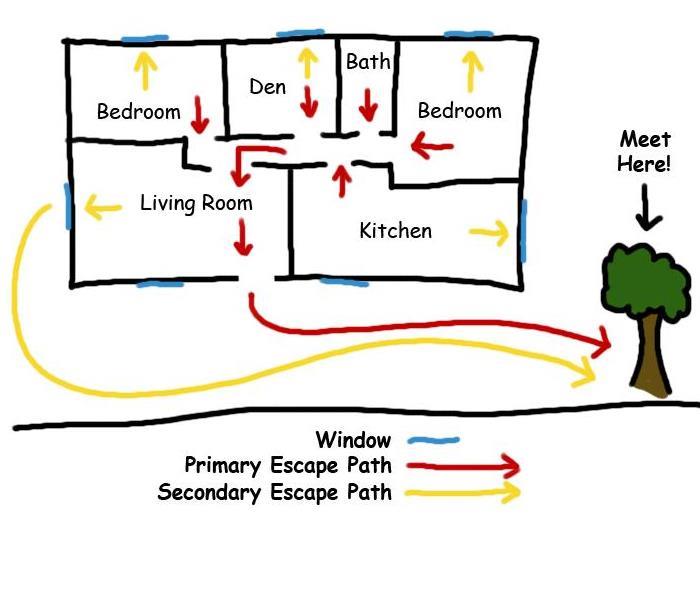 A fire escape plan example.
A fire escape plan example.
Did you know that if a fire starts in your home, you'll have just two minutes to escape? That's why it's important to have working smoke alarms in your home, develop an escape plan and practice that plan. Practice your plan until everyone in the household can evacuate in less than two minutes. Test smoke alarms every month and replace the batteries as needed. Consider placing escape ladders in rooms on upper floors. Identify two exits from every room. Install smoke alarms on every level of the home, including inside and outside each bedroom and in the basement.
Tips for creating and practicing your escape plan:
- Everyone in your household should know two ways to escape from each room in your home.
- Decide where to meet once you get outside.
- If a fire starts, you may have just two minutes to get to safety. So time your fire drills and find out: what’s your escape time?
- Smoke is dangerous. Practice low crawling.
- Teach household members what to do if their clothes catch fire: stop, drop and roll.
SERVPRO of Farmington Smoke and Soot Cleanup
8/23/2016 (Permalink)
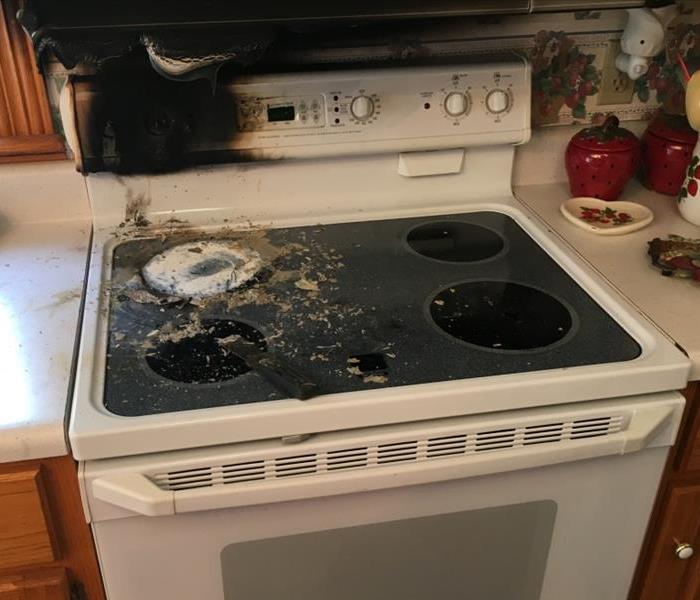 Kitchen Fire in Perryville, MO.
Kitchen Fire in Perryville, MO.
Smoke and soot facts:
- Hot smoke migrates to cooler areas and upper levels of a structure.
- Smoke flows around plumbing systems, seeping through the holes used by pipes to go from floor to floor.
- The type of smoke many greatly affect the restoration process.
Different Types of Smoke
There are two different types of smoke- wet and dry. As a result, there are different types of soot residue after a fire. Before restoration begins, SERVPRO of Farmington will test the soot to determine which type of smoke damage occurred. The cleaning procedures will then be based on the information identified during pretesting. Here is some additional information:
Wet Smoke- Plastic and Rubber
- Low heat, smoldering, pungent odor, sticky, smeary. Smoke webs are more difficult to clean.
Dry Smoke- Paper and Wood
- Fast burning, high temperatures, heat rises therefore smoke rises.
Protein Fire Residue- Produced by evaporation of material rather than from a fire
- Virtually invisible, discolors paints and varnishes, extreme pungent odor.
Our Fire Damage Restoration Services
Since each smoke and fire damage situation is a little different, each one requires a unique solution tailored for the specific conditions. We have the equipment, expertise, and experience to restore your fire and soot damage. We will also treat your family with empathy and respect and your property with care.
Have Questions about Fire, Smoke, or Soot Damage?
Call Us Today- 573-756-5191



 24/7 Emergency Service
24/7 Emergency Service
